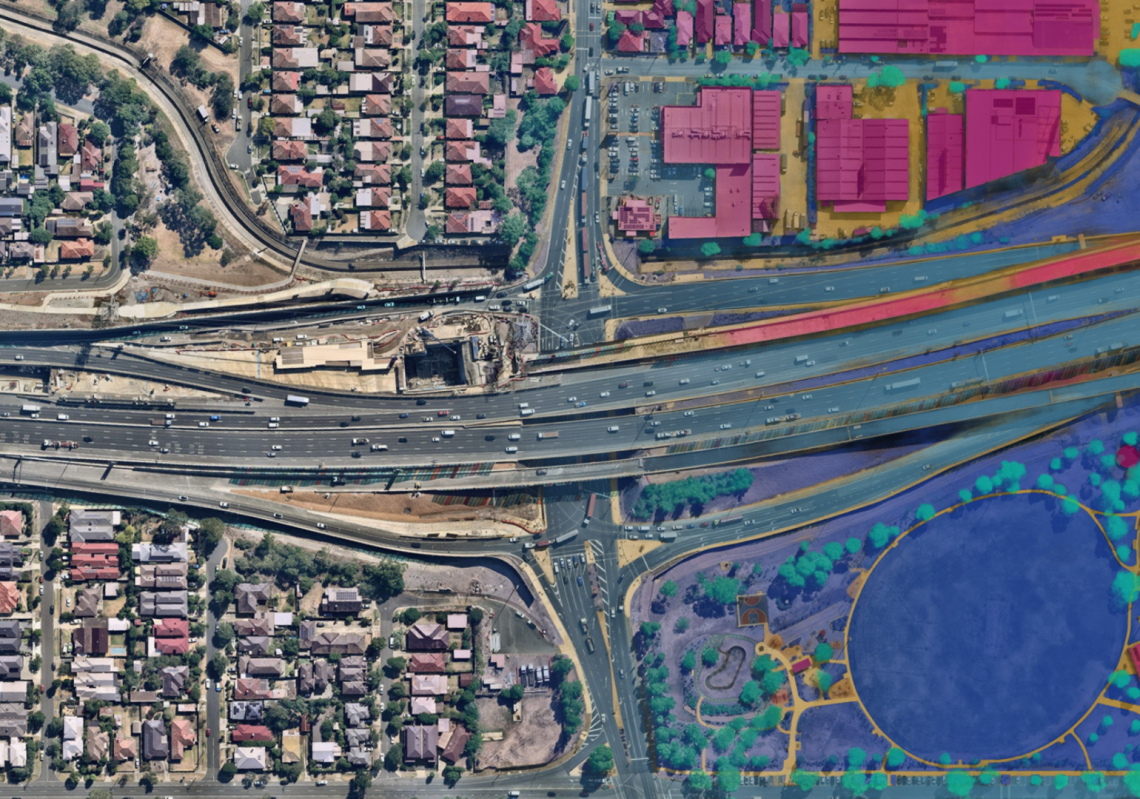As engineering and construction leaders grapple with reducing emissions, a recent research and major transport project shows timely, accurate and verifiable data is key.
Among the sustainability innovations being trialled on Victoria’s M80 Ring Road Completion are an onsite hydrogen generator and a system for calculating embodied carbon in design.
Ross Brookshaw is ACCIONA’s Sustainability Manager on the M80 Ring Road Completion, a major road project connecting Melbourne’s western and northern suburbs.
Speaking at an industry roundtable on the future of sustainable construction hosted by Nearmap and Engineers Australia, Brookshaw emphasised the need for “significant and timely action” on emissions across the engineering and construction sector.
The experience implementing sustainability initiatives on the M80 Ring Road Completion highlighted the challenges and opportunities facing broader industry decarbonisation efforts explored in recent research from Nearmap.
Decarbonising engineering and construction
Under the Paris Agreement, nations globally agreed to limit temperature rise to well below 2°C, while also striving to limit the rise to 1.5°C.
In line with those commitments, Australian national, state and territory governments have set targets to achieve net zero emissions between 2045 and 2050 – goals that require steep and rapid emissions cuts across all sectors.
Recent figures from the UN Environment Programme, show the building and construction sector contributes about 37 per cent of global emissions, partly due to the production of materials like cement and steel, alongside building and asset operations.
Alongside governments, construction industry leaders are committed to reducing emissions.
A survey commissioned by Nearmap of more than 250 leaders in the construction, engineering and property industries revealed the vast majority (95 per cent) consider emissions reduction as central to their sustainability agenda.
Moreover, all believe technology is important to achieving sustainability goals.
“We’ve discovered a significant gap between the usage of these technologies and the positive attitudes towards their impact,” Dan Paull, Executive Vice President and General Manager at Nearmap, said.
“About 83 per cent of business leaders in these industries are optimistic about the potential for geospatial technologies and artificial intelligence to drive substantial carbon emission reductions, and 93 per cent believe technology can help them achieve sustainability goals.
“In contrast, only 75 per cent are actually using those location intelligence technologies to achieve those outcomes.”
Overcoming challenges to create sustainable change
The survey revealed limited awareness and understanding of available technologies, a lack of technology tools that can help, and financial constraints as the biggest barriers.
Paull believes the results signal an opportunity to better leverage technology to improve sustainability outcomes.
“It’s not so much that we don’t have the technology, it’s about how we implement that technology in a way that allows us to continue to function and operate so it can happen seamlessly,” he said.
Brookshaw spoke about change management challenges when implementing sustainability initiatives.
The M80 Ring Road Completion was among the first major projects in Australia to pilot the use of a hydrogen generator on site during construction.
“It was a pretty momentous occasion to get it onsite,” he said, given the trial involved six months of engagement with stakeholders from regulators, clients and the construction workforce, as well as liaison with local residents.
“Even though it was only running for a short time, being able to use pure renewable hydrogen instead of a traditional diesel powered generator was a significant step forward.”
Brookshaw hopes the groundwork on the pilot will make things smoother and more time-effective – “days, not months” – next time.
Accurate, verifiable data leads to better outcomes
Engineers working on the detailed design of the M80 Ring Road Completion are also road-testing a Sustainability Carbon Viewer which calculates the embodied carbon of materials.
“The designer can get direct and almost immediate feedback on their design in terms of carbon impacts – which means they can tweak the design to get a better carbon output,” Brookshaw said.
He emphasised the importance of accurate, verifiable data.
“The sooner we can get real data, the sooner we can improve,” he said.
The importance of data was also emphasised by the results of the Nearmap survey, which showed the technologies deemed most useful for reducing emissions by respondents included:
- Environmental impact assessment and monitoring tools (57 per cent)
- Geospatial analytics and insights powered by AI (49 per cent)
- High-resolution aerial imagery of areas across Australia (45 per cent)
Sharing lessons from implementation
Paull is passionate about ensuring solutions are both smart and easily implementable.
“The focus shouldn’t solely be on what’s the grand thing you might do to make an enormous difference,” he said. “But also, what are the simple things that you can do many times that aggregate up across the industry, to start to have an impact.”
He provided the example of transport, a sector responsible for 21 per cent of Australia’s annual emissions. Paull said many vehicle movements in construction, engineering and property may not be necessary, with remote site visits powered by location intelligence an easily implementable solution enabling emissions reductions throughout the project lifecycle.
Brookshaw hopes everything they are learning by implementing sustainability initiatives on the M80 Ring Road Completion – “the good, the bad, and the ugly” – can help drive positive change across the sector.
“We’re going to be sharing what we learn – including things that didn’t go as planned – so that the next project can gain momentum faster. The more we can learn in real time, the more we can improve and set ourselves up for the future.”




